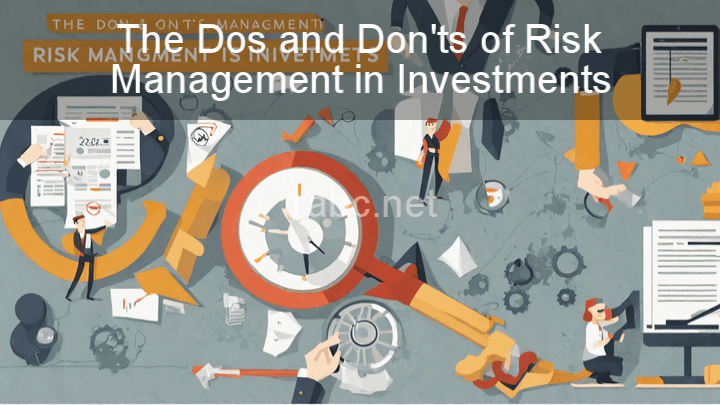The Dos and Don'ts of Risk Management in Investments

Introduction:
Investing in financial markets can be a rewarding endeavor, but it is not without risks. The key to successful investing lies in effectively managing those risks. Risk management is a critical aspect of investment decision-making that helps investors protect their capital while seeking growth opportunities. In this blog post, we will discuss the dos and don'ts of risk management in investments, providing you with valuable insights to make informed decisions and navigate the complexities of the market.
I. Understanding Risk:
Dos:
- Define risk: Before diving into the world of investing, it is essential to understand what risk means in the context of investments. Risk refers to the potential for losses or fluctuations in the value of investments. It can arise from various factors such as market volatility, economic downturns, industry-specific risks, or company-specific risks.
- Assess your risk tolerance: Every individual has a different risk appetite based on their financial circumstances, investment goals, and psychological makeup. It is crucial to assess your risk tolerance to determine the level of risk you are comfortable with. This assessment will help you align your investment strategy with your risk appetite and avoid making impulsive decisions during periods of market volatility.
- Diversify your portfolio: One of the most effective ways to manage risk is by diversifying your portfolio. Spreading your investments across different asset classes, such as stocks, bonds, real estate, and commodities, reduces the overall risk exposure. Diversification helps cushion the impact of losses in one investment with gains in others, providing a more balanced and stable portfolio.
- Conduct thorough research: Informed decision-making is the cornerstone of successful investing. Before investing in any asset, it is essential to conduct thorough research and analysis. This includes evaluating the financial health of a company, studying market trends, understanding macroeconomic factors, and keeping abreast of regulatory changes. By arming yourself with knowledge, you can make better-informed decisions and minimize the potential risks associated with investments.
Don'ts: - Ignore risk altogether: Many investors make the mistake of overlooking or downplaying the importance of risk. Ignoring risk can lead to significant losses and hinder your investment journey. It is crucial to acknowledge and actively manage the risks associated with investments to protect your capital and achieve your financial objectives.
- Rely solely on past performance: Past performance is not always indicative of future results. While historical data can provide valuable insights, it should not be the sole basis for making investment decisions. Market conditions, economic factors, and industry dynamics can change, rendering past performance irrelevant. It is important to consider multiple factors and conduct thorough analysis before making investment choices.
- Put all eggs in one basket: Concentrating your investments heavily in a single stock or sector exposes you to the risk of significant losses if that particular investment underperforms. By diversifying your portfolio, you reduce the risk of being heavily impacted by the performance of a single asset. Spreading your investments across multiple stocks, sectors, and asset classes helps mitigate risks and increases the potential for positive returns.
II. Setting Investment Goals:
Dos:
- Define your financial objectives: Before embarking on any investment journey, it is essential to define your financial objectives. Whether you are saving for retirement, funding your child's education, or buying a house, clearly articulating your goals will help you align your investment strategy accordingly. Your investment goals will determine the time horizon, risk tolerance, and expected returns, enabling you to make informed decisions.
- Create a diversified investment strategy: Once you have defined your financial objectives, it is important to develop a diversified investment strategy. This strategy should align with your goals and incorporate various asset classes that offer different risk-return profiles. By diversifying your investments, you can optimize your portfolio's performance while managing risk effectively.
- Regularly review and adjust goals: Setting investment goals is not a one-time activity. As life circumstances change and financial markets evolve, it is crucial to regularly review and adjust your goals. This ensures that your investment strategy remains aligned with your evolving needs and helps you stay on track to achieve your desired outcomes.
Don'ts: - Chase unrealistic returns: While it is natural to desire high returns on investments, it is important to set realistic expectations. Chasing unrealistic returns often leads to engaging in risky investment practices that may jeopardize your capital. It is essential to evaluate the risk associated with any investment opportunity and ensure that it aligns with your risk tolerance and investment objectives.
- Neglect long-term planning for short-term gains: In today's fast-paced and volatile markets, it is easy to get caught up in short-term fluctuations and make impulsive investment decisions. However, it is crucial to prioritize long-term planning and stick to your investment strategy. Short-term gains may provide temporary excitement, but long-term wealth creation requires discipline and a focus on your broader financial goals.
III. Managing Risks:
Dos:
- Develop an emergency fund: Building an emergency fund is a critical aspect of risk management. An emergency fund provides a financial safety net to handle unexpected expenses without disrupting your investment portfolio. It is advisable to set aside three to six months' worth of living expenses in a liquid and easily accessible account.
- Stay informed about market trends and economic factors: To effectively manage risks, it is essential to stay informed about market trends and economic factors that may impact your investments. Keeping track of changes in interest rates, geopolitical events, regulatory changes, and industry-specific news can help you make timely adjustments to your portfolio.
- Adopt a disciplined approach: Risk management requires discipline and adherence to predetermined principles. It is crucial to develop a systematic investment strategy that suits your risk profile and investment goals. By sticking to your investment plan, you can avoid making impulsive decisions driven by short-term market movements and emotions.
Don'ts: - Panic during market downturns: Market downturns are an inevitable part of investing. However, panicking and making rash decisions during these periods can lead to significant losses. It is essential to stay calm, assess the situation objectively, and avoid making knee-jerk reactions based on short-term market volatility. Remember that investing is a long-term journey, and market cycles tend to balance out over time.
- Neglect regular portfolio reviews: As market conditions change, it is important to periodically review your portfolio and make necessary adjustments. Neglecting regular portfolio reviews can expose you to unnecessary risks or cause your investments to become misaligned with your goals. By staying proactive and regularly assessing your portfolio's performance, you can make informed decisions and maintain an optimal risk-return balance.
Conclusion:
Risk management is an integral part of successful investing. By understanding and implementing the dos and avoiding the don'ts of risk management, you can protect your capital, achieve your financial goals, and navigate the complexities of the market. Remember to define your risk tolerance, diversify your portfolio, conduct thorough research, set realistic goals, regularly review your investments, and stay disciplined. Prioritizing risk management will provide a solid foundation for your investment journey and increase your chances of long-term success.
For further guidance and tools to manage risks effectively, consult with financial advisors, utilize risk management software, and stay updated with reputable financial publications. Investing is a continuous learning process, and by adopting a proactive approach to risk management, you can enhance your investment decision-making and maximize your returns.
FREQUENTLY ASKED QUESTIONS
What is risk management in investments?
Risk management in investments refers to the process of identifying, analyzing, and taking actions to mitigate or minimize the potential risks associated with investment activities. It is a crucial aspect of investment management as it aims to protect and preserve the value of the investment portfolio.
The primary goal of risk management in investments is to strike a balance between risk and return. By understanding the various types of risks, such as market risk, credit risk, liquidity risk, and operational risk, investors can make informed decisions and implement strategies to effectively manage and control these risks.
Risk management techniques often involve diversifying the investment portfolio, setting appropriate risk tolerances, conducting thorough research and analysis, and regularly monitoring and adjusting the portfolio as market conditions change. Additionally, investors may also use financial instruments like derivatives, hedging strategies, and insurance to further mitigate potential risks.
Ultimately, risk management in investments aims to protect capital, optimize returns, and ensure the long-term success of investment strategies. By effectively managing risks, investors can improve their chances of achieving their financial goals while minimizing the impact of unforeseen events or market downturns.
Why is risk management important in investments?
Risk management is crucial in investments due to several reasons:
- Preservation of Capital: By implementing risk management strategies, investors aim to protect their capital from potential losses. Investing inherently involves uncertainty and volatility, and risk management helps minimize the negative impact of adverse events.
- Mitigation of Losses: Proper risk management enables investors to identify and assess potential risks in their portfolios. By understanding the risks associated with particular investment options, investors can make informed decisions and take steps to limit or mitigate potential losses.
- Consistency in Returns: Risk management helps investors maintain consistent returns over time. By diversifying their portfolios across different asset classes, industries, and geographical regions, investors can reduce the impact of fluctuations in any single investment and achieve more stable returns.
- Peace of Mind: Implementing risk management strategies provides investors with a sense of security and peace of mind. By having a plan in place to address potential risks, investors can navigate uncertain market conditions with confidence, knowing that they have a strategy to protect their investments.
- Long-Term Financial Goals: Effective risk management aligns investments with long-term financial goals. By understanding and managing risks, investors can ensure that their investment strategies are aligned with their risk tolerance, time horizon, and overall financial objectives.
Overall, risk management is essential in investments as it helps investors protect their capital, mitigate losses, achieve consistent returns, gain peace of mind, and align their investments with long-term financial goals.
What are the dos of risk management in investments?
When it comes to risk management in investments, there are several key "dos" that can help individuals or organizations navigate potential risks more effectively. Here are some dos of risk management in investments:
- Diversify your portfolio: Spreading investments across different asset classes, sectors, and markets can reduce the impact of any single investment's poor performance. Diversification helps to mitigate risk and potentially increase returns.
- Set clear investment goals: Defining your investment objectives and risk tolerance is crucial. Having clear goals in mind enables you to make investment decisions that align with your financial objectives and risk appetite.
- Conduct thorough research: It is essential to thoroughly evaluate potential investments before committing your funds. This includes assessing the underlying investment's fundamentals, performance history, risk factors, and any relevant market or industry conditions.
- Regularly monitor investments: Stay informed about the performance of your investments and keep track of any changes in market conditions or factors that may affect their value. Regularly review your investment strategy to ensure it remains aligned with your goals.
- Consider risk-adjusted returns: Instead of solely focusing on the potential return of an investment, also take into account the level of risk involved. Investments with higher returns tend to have higher risk, so it's important to assess the risk-reward tradeoff.
- Set realistic expectations: Be realistic about the potential risks and returns associated with your investments. Avoid falling into the trap of unrealistic expectations, as it can lead to poor decision-making and increased exposure to risk.
- Seek professional advice: If you're uncertain about risk management or investment decisions, consider consulting with a financial advisor or investment professional. They can provide valuable insights and help create a well-balanced and diversified investment strategy.
Remember, risk is inherent in investments, and while risk management practices can help mitigate potential pitfalls, they cannot eliminate them entirely.
What are the don'ts of risk management in investments?
There are several common "don'ts" of risk management in investments that are important to keep in mind. These include:
- Don't ignore risk: It is crucial to acknowledge and understand the risks associated with any investment. Ignoring or downplaying risks can lead to significant losses.
- Don't invest without research: Avoid making investment decisions without conducting thorough research. Failing to analyze the investment's prospects, market conditions, and potential risks can result in poor outcomes.
- Don't put all your eggs in one basket: Diversification is key to managing risk. Investing all your funds in a single asset or a limited number of assets increases vulnerability to market fluctuations. Spreading investments across various asset classes can help mitigate risk.
- Don't follow the herd: Blindly following the crowd can be risky. Just because certain investments are popular doesn't guarantee their success. It's important to make informed decisions based on your own research and risk tolerance.
- Don't neglect risk assessment: Regularly assess and reassess the risks associated with your investments. Economic conditions, industry trends, and other factors can change over time, impacting the risk profile of your investments.
- Don't rely solely on past performance: Past performance is not always indicative of future results. Investing based solely on historical returns may lead to unrealistic expectations and increased risk.
- Don't overlook the importance of liquidity: Consider the liquidity of your investments. Illiquid investments can be difficult to sell quickly, which may limit your ability to react to changing market conditions or unexpected events.
Remember, risk management in investments requires careful consideration and proactive decision-making to protect your capital and achieve your financial goals.

